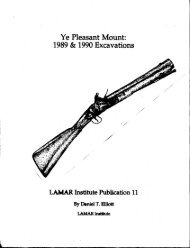Stirring Up a Hornet's Nest: - UGA Laboratory of Archaeology ...
Stirring Up a Hornet's Nest: - UGA Laboratory of Archaeology ...
Stirring Up a Hornet's Nest: - UGA Laboratory of Archaeology ...
Create successful ePaper yourself
Turn your PDF publications into a flip-book with our unique Google optimized e-Paper software.
John Finley entered the service <strong>of</strong> the United States at the age <strong>of</strong> 16 years on the 15th day <strong>of</strong> August 1776, that he was an<br />
enlisted soldier or recruit and enrolled as such by one Sergeant Emmit for the particular service <strong>of</strong> a corps <strong>of</strong> mounted<br />
horsemen called as the Applicant believes the Georgia Provincials or Rangers whose sole duty appeared to be the frontier<br />
protection in Georgia against Indian depredations and Tory revolt against the Country, that he enlisted under the said<br />
Sergeant Emmit in Craven County afterwards Ninety Six District and now Laurens District on the 15 th day <strong>of</strong> August 1776<br />
for the term or period <strong>of</strong> time <strong>of</strong> 18 months, that he with other recruits <strong>of</strong> like character were marched from the this place in<br />
the State <strong>of</strong> South Carolina by the said Sergeant Emmit to a place in the State <strong>of</strong> Georgia called Kettle Creek where he was<br />
placed under the command <strong>of</strong> one Captain McFarlin who had rendezvoused his company at Kettle Creek for about the period<br />
<strong>of</strong> one month and from thence was marched by Captain McFarlin to a place called Neels or Neals fort [sic, probably Nail's<br />
Fort] on the frontiers <strong>of</strong> Georgia where the company joined another but under what Captain the Applicant does not recollect,<br />
at Neal's Fort about the number <strong>of</strong> three companies were embodied collected or organized, and from thence the Applicant<br />
was marched with the said troop under the command <strong>of</strong> a Major Marberry [sic, probably Leonard Marbury] to a place called<br />
Fort Barrington on the Altamaha River in the State <strong>of</strong> Georgia which place was designated the Head Quarters <strong>of</strong> the troops,<br />
and at which place the troops had a battle with the Indians who were defeated with a loss not known to the Applicant but with<br />
a loss on the part <strong>of</strong> the troops <strong>of</strong> five or six men killed, and from which place the troops alternately issued and moved in<br />
small squads & scouting parties up & down the said River & over to the North & South bank through the country to check<br />
and intimidate the inroads <strong>of</strong> the Indians and other enemies <strong>of</strong> the Country for about the period <strong>of</strong> seven months, ending in<br />
April or May 1777 (Footnote.com 2008 [John Finley W1257]).<br />
Paul Findley (or Finley) recounts a similar story to the preceding John Finley account. Private Findley<br />
stated in his pension account,<br />
that he [Findley] enlisted under the said Sergt. Emmit on the fifteenth day <strong>of</strong> August one thousand seven hundred & seventy<br />
six for the term or time <strong>of</strong> Eighteen months; that on the day <strong>of</strong> his said enlistment he was a resident <strong>of</strong> and living in Craven<br />
District afterwards known as Ninety Six District and at present called Laurens District in the State <strong>of</strong> South Carolina; that he<br />
with other recruits <strong>of</strong> like character were marched from the place by the said Sergt. Emmit to a place in the State <strong>of</strong> Georgia<br />
called Kettle Creek, where he was placed under the command <strong>of</strong> one Capt. ___ [blank in original] Mc Farlin [McFarlane ?]<br />
who it appeared had rendezvoused his company at Kettle Creek for about the period <strong>of</strong> one month & from thence was<br />
marched under said Capt. McFarlin's company by him to a place called Nails or Neal's fort on the frontier <strong>of</strong> Georgia where<br />
this company joined another but under Capt. The applicant does not recollect; at which place about the number <strong>of</strong> three<br />
companies were embodied, collected, organized and from thence the applicant was marched with the said troops under the<br />
command <strong>of</strong> Major __ [blank in original] Marberry [probably Leonard Marbury, also spelled Marbrey] either Leonard<br />
Marbury or to a place called fort Barrington on the Altamaha River in the State <strong>of</strong> Georgia which place was designated their<br />
Headquarters…(Pension account, Paul Findley W9440X).<br />
John Finley’s and Paul Findley’s versions are important evidence <strong>of</strong> a military encampment on Kettle<br />
Creek, which preceded the February 14, 1779 battle. Both soldiers attest that they were taken to the area by<br />
a Sergeant Emmit and were later under command <strong>of</strong> a Captain McFarlin [possibly McFarland]. Captain<br />
McFarland’s company spent about one month camped at Kettle Creek in late 1776. Such a prolonged<br />
encampment by a company <strong>of</strong> soldiers would likely leave an archeological footprint. Louise Hammett has<br />
suggested that Sergeant Emmit may be the same as her ancestor, James Hammett and that the differences<br />
can be explained by a variant spelling <strong>of</strong> the surname (Hammett 2008:48; Louise B. Hammett, personal<br />
communication July 11, 2008). She argues that in a largely illiterate population, the pronunciation <strong>of</strong> the<br />
Hammett surname was interpreted variously. Hammett’s interpretation <strong>of</strong> Sergeant Emmit and James<br />
Hammett being the same person may be valid. Warren noted that English and French pronunciation in the<br />
18 th century typically did not pronounce the “H” at the beginning <strong>of</strong> a word, which would further support<br />
Hammett’s theory that Emmit and Hammett was the same person (Mary Bondurant Warren, personal<br />
communication, January 1, 2009). A preliminary search for non-commissioned <strong>of</strong>ficers in the Georgia and<br />
South Carolina militias and Continentals yielded no results for the surname Emmit. James Hammett did<br />
attain the rank <strong>of</strong> Sergeant in the Wilkes County militia and was one <strong>of</strong> the earliest Euro-American settlers<br />
on Kettle Creek. James may already have been familiar with the Kettle Creek area by 1776 or 1777 when a<br />
military camp was established there.<br />
Private Robert Ellis<br />
Private Robert Ellis served several tours in the South Carolina militia and was at Kettle Creek in 1781. In<br />
1838 Ellis stated that, “He again Volunteered under Captain Robert Maxwell in the fall <strong>of</strong> 178_[last digit<br />
omitted] to serve three months under Colonel Anderson and was marched to the Kittle Creek and little<br />
Brasstown under General Pickens and was in several skirmishes” (Footnote.com 2008 [Robert Ellis<br />
S26084]). It is unclear from Ellis’ testimony, whether he participated in the February 14 battle, although he<br />
was present in that area with other South Carolina militiamen later in the war.<br />
78










